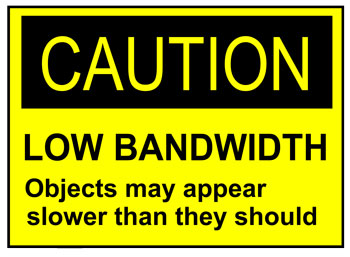By: John Shepler
Insufficient bandwidth severely hinders productivity and increases stress levels. Slow loading times for websites, cloud documents, and collaborative platforms, as well as choppy video calls, are just a few of the frustrations. Increased processing power or RAM won’t solve this; the only solution is greater network bandwidth.
 What Bandwidth Should You Aim For?
The required bandwidth varies depending on your usage patterns and the quality of bandwidth you’re using.
What Bandwidth Should You Aim For?
The required bandwidth varies depending on your usage patterns and the quality of bandwidth you’re using.
Traditional T1 lines are becoming outdated. While suitable for point-of-sale systems, small offices with basic internet and phone needs, and areas with limited options, their bandwidth is restricted. Combining T1 lines for up to 10 Mbps is possible but expensive, making it a temporary solution.
Fiber: The Superior Option The future of connectivity is fiber optic. Its virtually limitless capacity makes it an ideal long-term solution. Fiber optic cables use multiple strands and wavelength division multiplexing to deliver exceptional bandwidth.
Fiber offers additional advantages. Besides its high bandwidth ceiling (up to 10 Gbps commonly available, with 100 Gbps in select areas), Carrier Ethernet services on fiber are highly scalable. Unlike legacy SONET systems that require different interfaces for different speeds, Ethernet over Fiber functions like LAN Ethernet. The port’s capability determines the maximum speed, allowing for easy upgrades. For instance, you can start at 10 Mbps and upgrade to 100 Mbps or even 1 Gbps with a Gigabit Ethernet WAN port.
Bandwidth adjustments are straightforward and quickly implemented by most providers. Some offer browser-based control panels for on-demand adjustments, while the future may bring intelligent systems that automatically optimize bandwidth allocation.
Why 10 Mbps is a Good Starting Point Getting fiber installed, or “lighting” your building, is the first step. This involves activating the fiber strands with laser light. In multi-tenant buildings, this often means other tenants can also access fiber bandwidth services.
If you’ve reached the limits of T1 lines, are dissatisfied with cable broadband, and want to avoid satellite internet’s latency and capacity issues, entry-level fiber is a strong option. It provides a foundation for future upgrades.
10 Mbps Ethernet over Fiber is a significant upgrade from a 1.5 Mbps T1 line and is often more cost-effective than bonding multiple T1 lines. Copper-based T1 lines are priced per line, each with limited bandwidth, while fiber offers more bandwidth for a comparable cost.
Is Fiber Expensive? While true for early SONET fiber optic services, newer Ethernet over Fiber services are competitively priced and often utilize independent networks. Many providers are eager to establish their fiber networks and attract businesses seeking high-speed internet.
Ethernet over Copper has long offered double the bandwidth (3 Mbps) for the price of a T1 line. Now, Ethernet over Fiber provides even more bandwidth (10 Mbps) at a similar cost. In some cases, it might even be cheaper than your existing T1 contract.
The cost per Mbps for Ethernet over Fiber decreases with higher bandwidth tiers (10, 100, 1000 Mbps), similar to volume discounts.
Bandwidth Quality: Dedicated vs. Shared T1, SONET, and other traditional telecom services offer dedicated, symmetrical bandwidth. This means consistent speeds for both upload and download, making them reliable for private lines and Dedicated Internet Access.
Ethernet over Copper and Fiber function similarly, providing a dedicated connection with no usage limits. You have complete control over your bandwidth, ensuring consistent performance for cloud applications or other network activities. Dedicated connections guarantee low latency, minimal jitter, and minimal packet loss, which are essential for high-performance applications.
In contrast, shared bandwidth options like DSL, cable broadband, satellite, and cellular wireless often have slower upload speeds than download speeds, and the available bandwidth fluctuates based on concurrent users. While these services might seem cheaper, the bandwidth quality differs. Heavy users may also face usage restrictions, leading to additional charges, throttling, or service termination.
Is 10 Mbps Necessary? While 10 Mbps is a popular starting point, replacing lower-bandwidth services like T1 and serving small businesses well, larger offices, and those involved in video production or distribution typically require more.
100 Mbps Fast Ethernet is common for businesses transitioning to cloud services or with numerous employees relying heavily on the internet. Gigabit Ethernet (1000 Mbps) is surprisingly affordable and often eliminates bandwidth concerns for many companies. Larger enterprises are adopting 10 Gbps as their standard, while 100 Gbps represents the high-end WAN bandwidth service currently available.
Choosing an Ethernet port with sufficient capacity for future growth is crucial. Even if starting at 10 Mbps, a 100 Mbps port is recommended. Some carriers now install Gigabit Ethernet ports proactively, anticipating future demand.
If you’re considering upgrading from copper-based bandwidth services to Ethernet over Fiber, it’s worth exploring the available options and costs. Requesting a quick fiber optic service check in your area can help determine the best solution for your needs, with expert consultants available to guide you.
Note: Products with the low bandwidth caution sign shown on this page, along with many other computer and networking themes, are available through the Gigapacket Tech Gifts Store.

